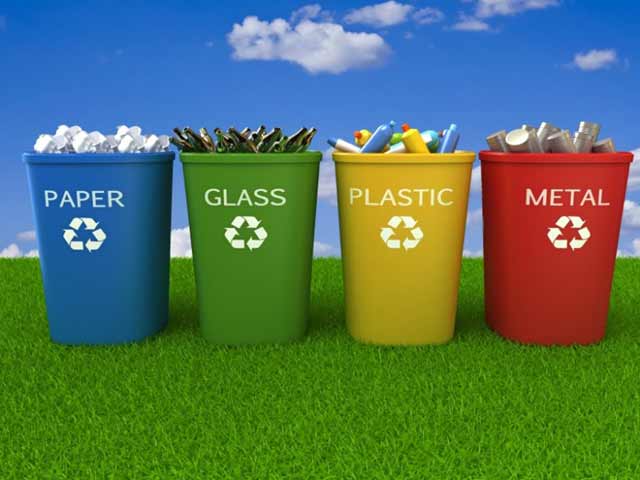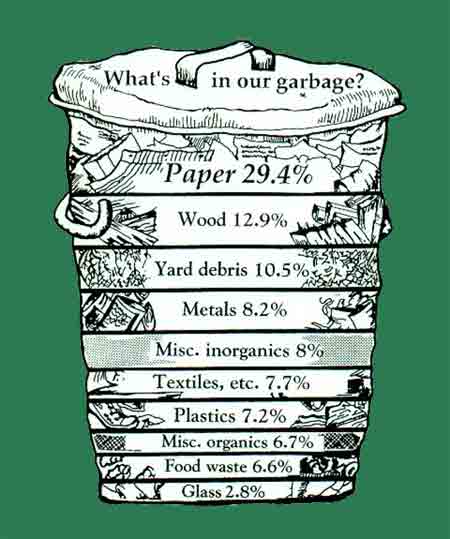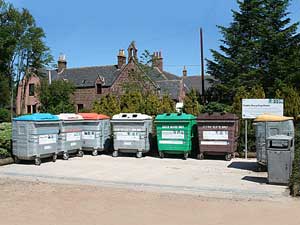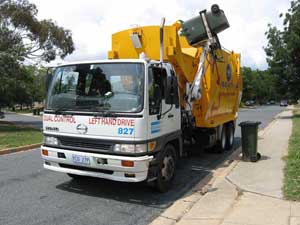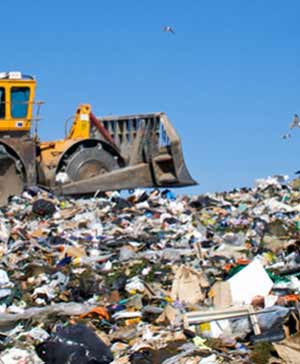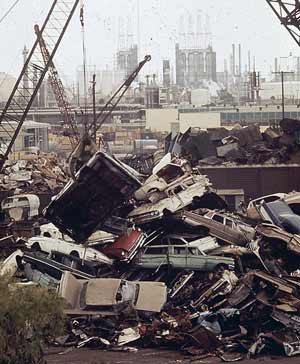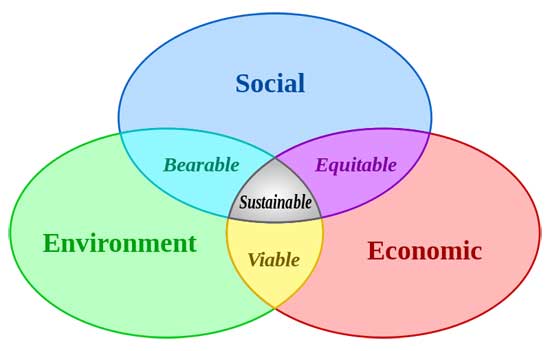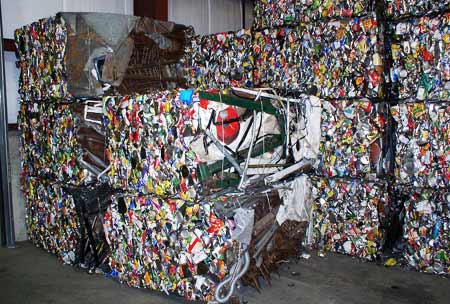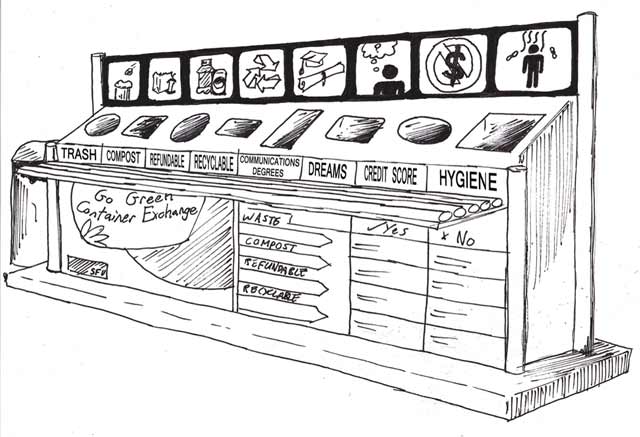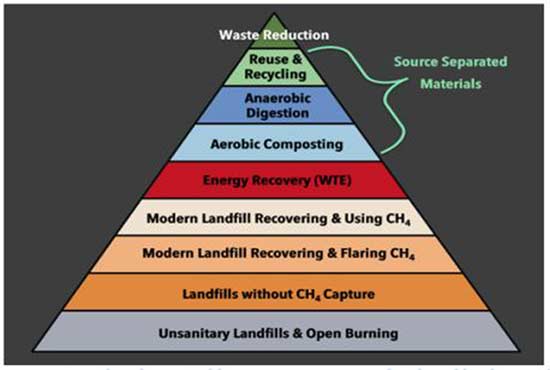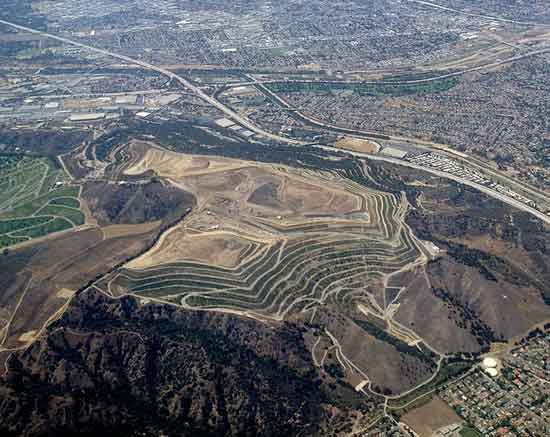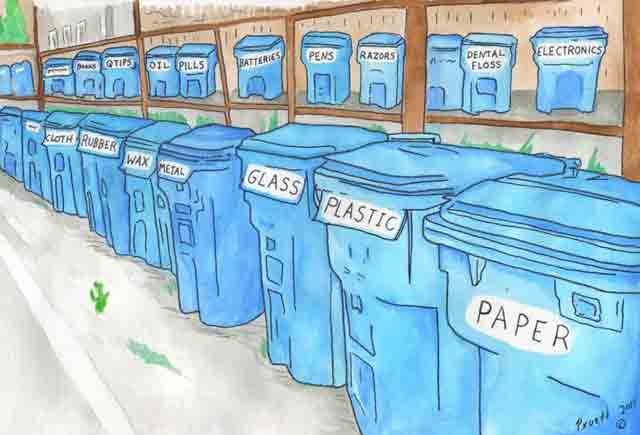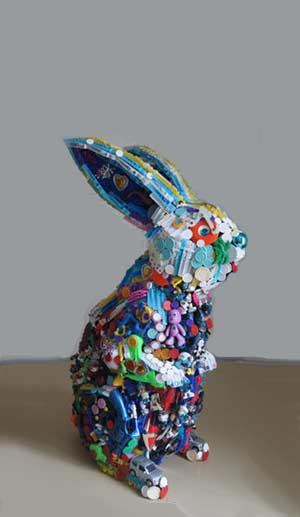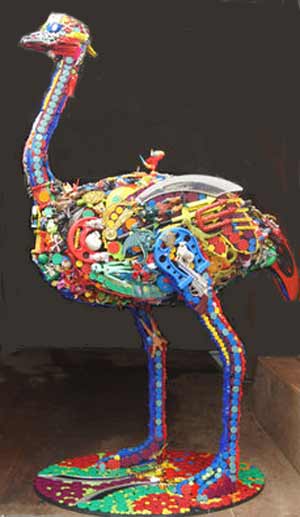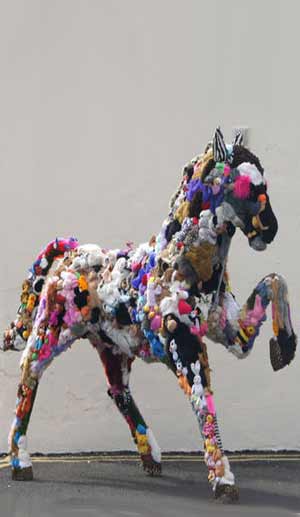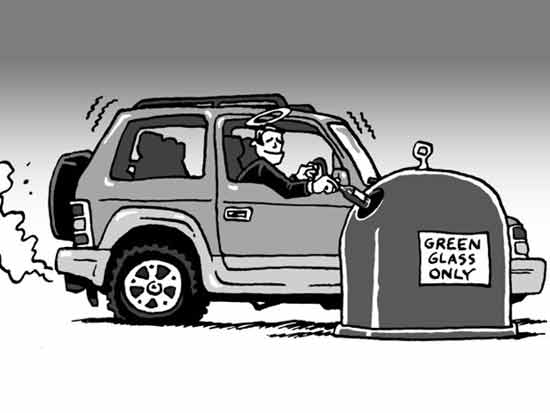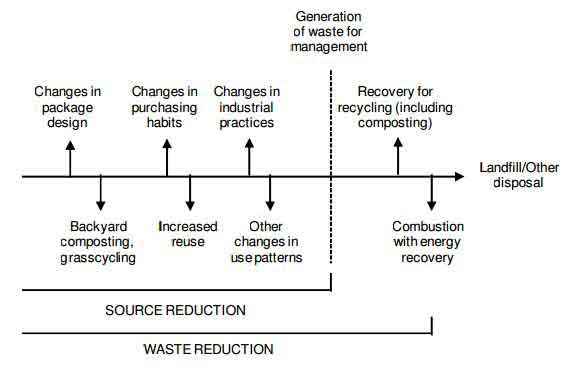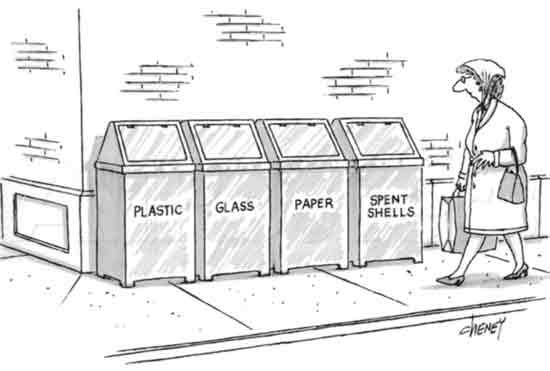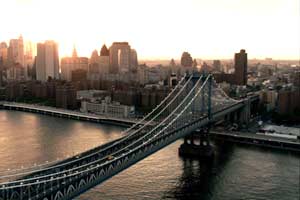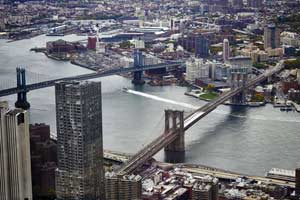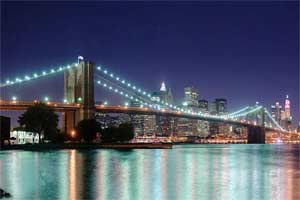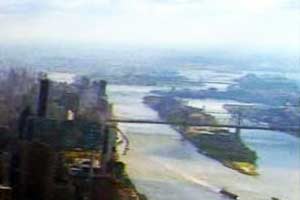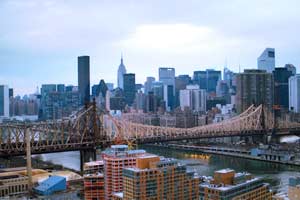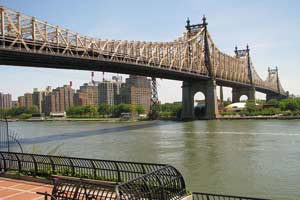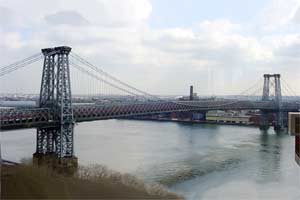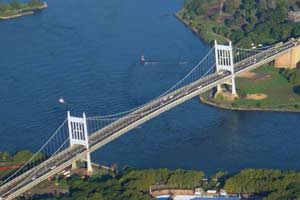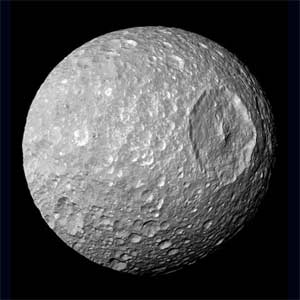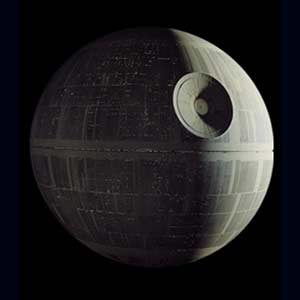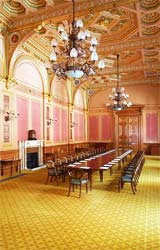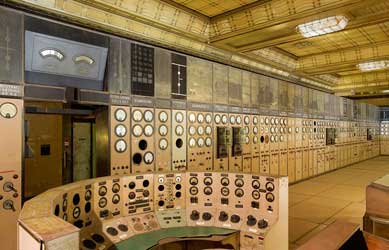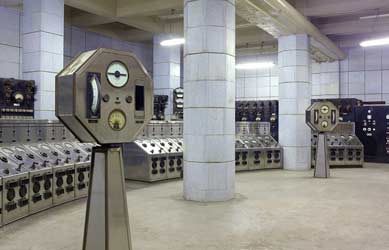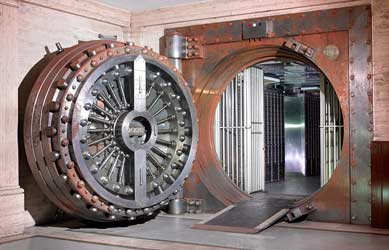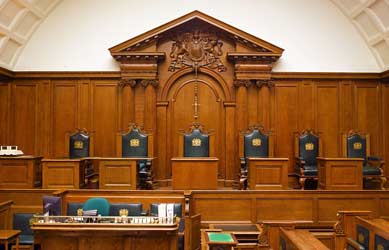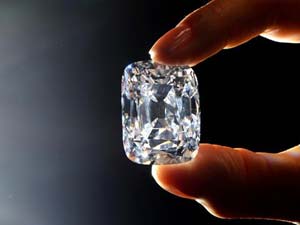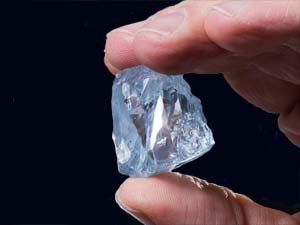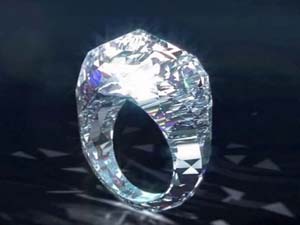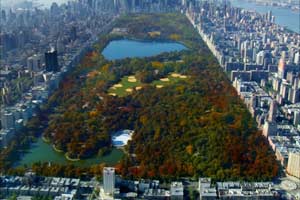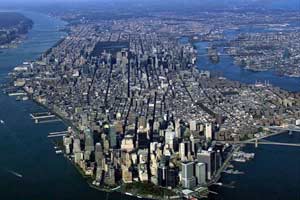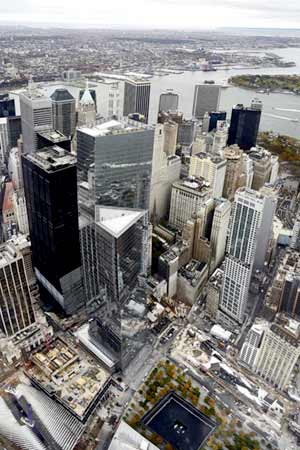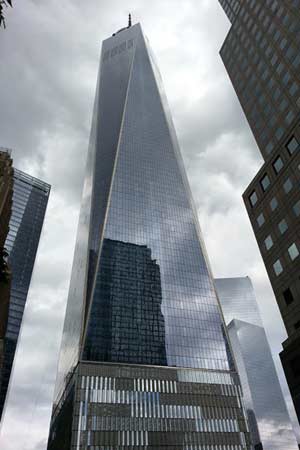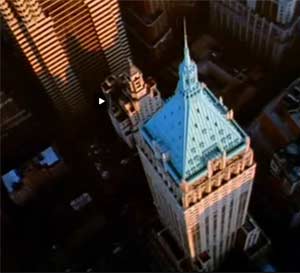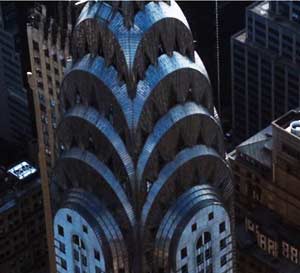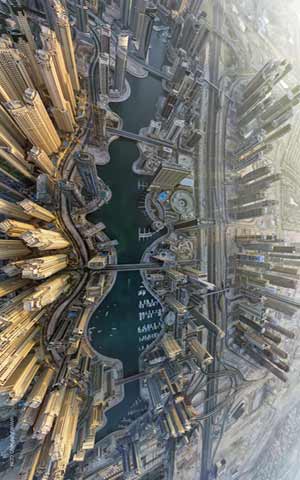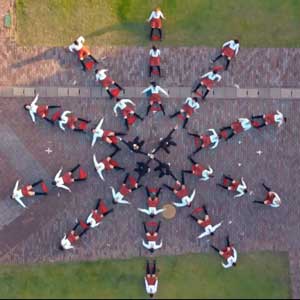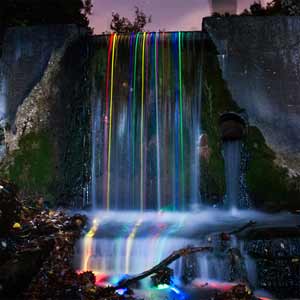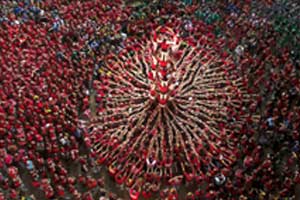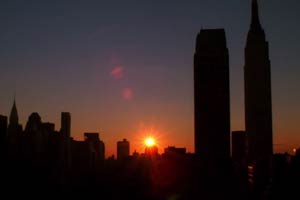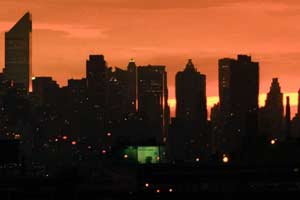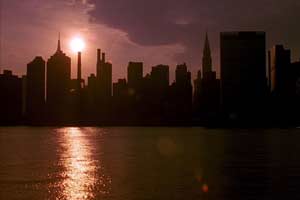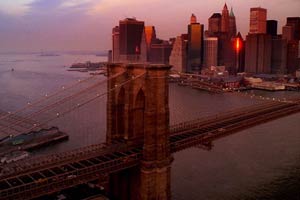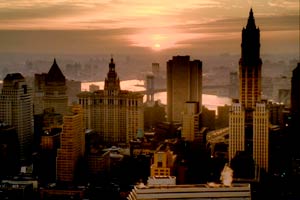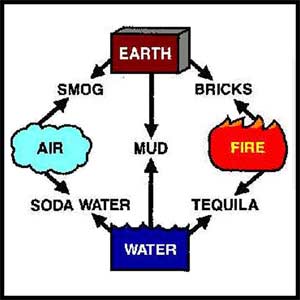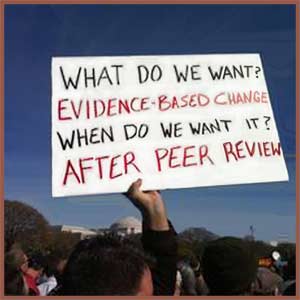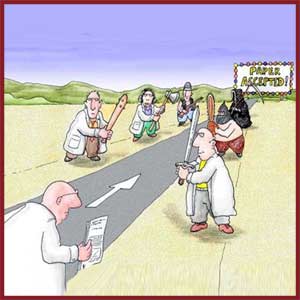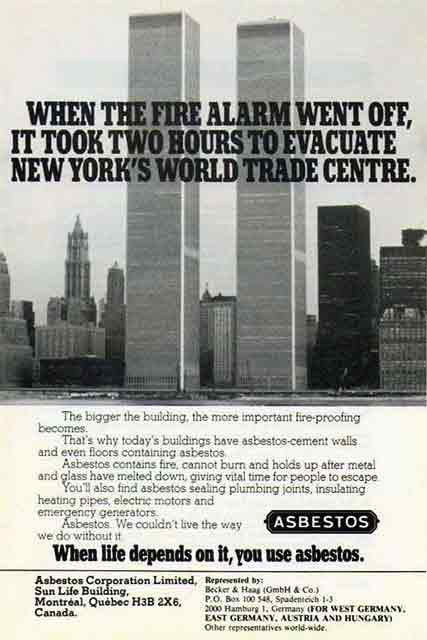We don’t need more recycling, we need a completely different system of closed-loop manufacturing.
No matter how many cans I crush, my personal actions at the consumer level are of very little importance in getting us there.
Waste Not?
Nov. 14, 2014
Rethink, Reduce, Redesign, Repair, Reuse, Repurpose, Recycle, Recover, Remove
Repeat
Like most of my neighbours, I sort my waste into paper-and-cardboard / glass / random plastics / random metals. I put everything out at once, in bundles or boxes for the first category and in plastic bags for all the rest. Oh, and a bin for the non-recyclables. It all gets picked up at right about the same time, involving three different trucks: one for refuse, one for paper and cardboard, and one for the rest.
I do this weekly. The items are clean, flattened, and/or washed. I’m not required to do that much, or even to recycle domestic waste at all (with a few exceptions discussed later), and the fact that I participate gives me a warm glow. I’m helping the environment. I deserve to feel a tiny bit smug.
Oh, really?
Why not gather paper and cardboard into separate bundles? Bag glass by colour? Sort plastics into recycle categories? (I’ve had to do that at other places I’ve lived in the past.) It’s because I don’t have the room. Or the time. (Or the interest, if I’m honest.) Even more importantly, the people who pick it up don’t have that many sorting partitions on their trucks. Things get merged back together to be sorted (along with everyone else’s stuff) later. So why should I bother to go further? To get more benefit, I’d pretty much have to deliver my stuff to the recycle centre myself. I’d have to buy a car (of course it would be used).
Thus, I feel I’m performing what’s expected of me (my civic duty, if you will) and that’s important. The city pays for the recyclables pickup, whereas I pay directly for waste pickup (whose charges to the customer rise exponentially with the rise in tip fees). Moreover, the city can offset their pickup costs by selling the sorted recyclables. And they’re extending the life of our local landfill in the process. So it’s all a win-win, right?
Maybe. Maybe not.
My city has “free” kerbside pickup, so that increases participation. However, people in the suburbs get recycle bins as well, but not those of us in the central business district. Instead, we must stack our stuff on the footpath. That means when the wind blows hard (a regular occurrence in Wellington), I can’t put the plastics out because the wind can start the bags rolling down the street. If a passing car hits one and bursts open the bag, then flattened bottles and jugs blow every which way, littering the neighbourhood. If my neighbours aren’t also careful, then I may end up with my yard full of litter anyway. And the washing, folding, and sorting of all that stuff takes up an hour or so of my time every week. Washing the glass and plastic requires hot water and soap. And there are now three trucks stopping at each building on my street instead of only one.
Is my recycling a net benefit overall? How can I tell? The actual dollar figures involved aren’t discussed much.
What Choices for Domestic Recycling Need to Be Made?
- What can be recycled?
To the aforementioned paper/cardboard, glass, plastic, and metal, you can (if your municipality allows) add garden waste, food waste (salads are the food type thrown away in greatest proportion — more than 45% of all salad purchases will be wasted — while potatoes account for the largest quantity), e-waste, textiles, rubber, carpets, Styrofoam, batteries, used oil, no-longer-working-or-no-longer-wanted appliances (large and small), unwanted or broken furniture, and junked vehicles and implements. Between 2/3 and 3/4 of household waste is currently recyclable. But not every municipality wishes to pick up every item you want to get rid of. For example, in Wellington, we take our e-waste to a centre about 3 blocks away and pay a drop-off fee (currently NZ$13 for a flat screen or $20 for a CRT – see their current price list). Guiyu is China’s controversial electronic-waste recycling zone. Is that where my discarded monitors are ending up? I’ve never asked.
- How is recycling in your area being handled?
Not at all? At drop-off points? At buy-back centres? Via container deposit systems? Via commercial kerbside pickup (where the user pays)? Or via municipal kerbside pickup (where the taxpayer pays)?
Is recycling mandatory in your municipality? If so, how are the rules enforced? Are clear plastic garbage bags required so the trash police can ensure you aren’t throwing away the wrong things? Where will it end?
The types of bins which would suit a detached 5-bedroom house in the country would be unsuitable for a 20-storey block of flats in the inner city. Councils must take all kinds of things into account when they plan the frequency of waste and recycling collections. The size and type of the container plays a key part.
- What processing must be done by the household?
Ease of collection correlates with participation while reduction in preparation time much less so. In other words, if I feel I’m investing effort in recycling, then I more easily accept that my participation has value, and I’m actually doing something to help. But many kerbside pickups are switching to a single-stream collection system — all waste is tossed in together. This switch can make people suspicious: if there’s no longer any need to separate different materials, is everything really just being buried or burned?
In fact, the switch towards single-stream collection is being driven by new technologies that can identify and sort the various materials with little or no human intervention. Single-stream collection makes it more convenient for householders to recycle and means more materials are diverted from the waste stream. Paper and plastic items are spread out on a conveyor belt in a single layer. When illuminated by a halogen lamp, each type of material reflects a unique combination of wavelengths in the infra-red spectrum that can be identified, much like a fingerprint. By analysing data from a sensor that detects light in both the visible and the near-infra-red spectrum, a computer is able to determine the colour, type, shape and position of each item. Air jets are then activated to push particular items from one conveyor belt to another, or into a bin. Numerous types of paper, plastic or combinations thereof can thus be sorted with up to 98% accuracy. (Does it save money overall? I was unable to determine that.)
Japanese municipal data reveal that municipalities implement recycling programmes that fit the demographic profiles of their residents. Municipalities with a considerable number of single-recycler households tend to implement simple waste separation programmes. The labour market positions of spouses have different impacts on recycling policies. Municipalities implementing comprehensive recycling programmes collect plastic bottles and containers more frequently than do other municipalities.
- What are the potential problems?
Scavengers: it can be profitable to go through others’ bins looking for metals and PET plastics — the higher-value items — to sell directly; however, that leaves lower-value scrap and therefore lower or negative profits for the community.
When items are carelessly secured they can succumb to wind or dogs and become neighbourhood litter.
Some people will free ride, tossing in verboten items they just want to be rid of.
The complexity of the process puts some people off: in each locale the rules (and violation penalties) are often different.
In general, higher costs are associated with recycling than with putting waste into a landfill or incinerating it. Sometimes the costs are much higher.
Random Re-cycling-Related Trivia
Price of 10 pencils made from “recycled twigs,” from the Nature Company: $39.50
Tons of trash generated last January by NFL-sponsored Super Bowl events: 313
Percentage of this later reused or recycled: 41
Number of the 10 largest environmental magazines that are printed on recycled paper: 3
Number of the 10 billion plastic Coke bottles distributed in the US each year that are made from recycled material: 0
(The aluminium Coke cans ARE made from recycled goods, however — so buy your Cokes in cans if it matters a lot.)
Where Does Our Refuse End Up?
Barge? Processing plant? Incinerator? Landfill after all? Slow boat to China? Pacific Garbage Patch?
Where does it all go? Probably Asia, particularly China, the largest importer of recycling from the rich world. Electric cords, for example, may turn up in Guangdong province where factories salvage the copper wire and melt the stripped plastic into new slippers. China’s thriving economy is desperate for stuff that consumers in America and elsewhere thoughtlessly throw away. This multibillion-dollar recycling trade stands as a globalisation success albeit an unsung one that turns over as much as $500 billion annually and employs a huge number of people. Building booms in China, have caused an explosion of demand for steel, copper and other resources in short supply there, so it imports metals, often as scrap. Americans, meanwhile, have more scrap than they can handle because they have less demand for manufacturing materials (labour costs are too high and environment laws too strict for cost-effective scrap salvaging). Here, recycling is good for business.
People now worry more about the afterlife of their mobile phones than they do their cars. Why? Because of the invention of the motor shredder, which turns old vehicles into scrap metal. In 1970 America had at least 20 million abandoned rusting cars scattered across the landscape. By 2012, more than half were gone. As the world’s biggest car buyer today, China has become the fastest growing market for motor shredders.
It’s often cheaper for American scrap-yards to send their stuff to China than to process it locally. Shipping companies hauling goods to the US would rather not return to China empty so they offer discounts on what they call backhauls.
The recycling industry manages to squeeze value from used goods, but unfortunately nothing is 100% recyclable. The special chemistry of many products, such as iPhone touchscreens, means they can’t be recycled. Consumers should be more aware of which products turn into nasty wastes and keep nudging companies to design easy-to-repair recyclable products. Discarding waste in China is reportedly less regulated.
Over time, recycling rates in the US have increased from just over 6% of municipal solid waste (MSW) generated in 1960 to 10% in 1980, 16% in 1990, 29% in 2000, to 34% in 2010. Disposal of waste in landfills has decreased from 94% of the amount generated in 1960 to under 54% of that generated in 2011. The US state of Maine recycles 48% of waste while the state of Louisiana recycles only about 1%. Paper products are the most recycled items while food waste, wood, and plastics are the least recycled. For example, the generation of plastic trash bags amounted to a million tons in 2011, but there was no significant recovery for recycling. More than 3 times as much waste as plastic bags is generated by disposable diapers, both for infants and adult incontinence products, but there’s no significant recycling or composting identified for them, either.
Pressures: Social, Environmental, and Economic
When a city introduces a kerbside recycling programme, the sight of all those recycling trucks driving around can raise doubts about whether the collection and transportation of waste materials requires more energy than it saves. A Danish review of 55 life-cycle analyses (selected for rigorous methodology) compared the impact of recycling with that of burying or burning particular types of waste material. In 83% of all scenarios that included recycling, it was indeed better for the environment. (Cheaper? Since it didn’t say, I’m guessing no.) Perhaps the most valuable benefit of recycling is saving energy and/or reducing greenhouse gases and pollution by substituting scrap for virgin feedstock. Extracting metals from ore is, in particular, extremely energy-intensive. Recycling aluminium can reduce the energy required by as much as 95%, so there’s a ready market for cans. Savings for other materials are lower but substantial: 70% for plastics, 60% for steel, 40% for paper, and 30% for glass. Recycling reduces smog, acid rain, and waterway contamination. But net savings? If it’s high, participation will be correspondingly high.
But according to the second law of thermodynamics, each time energy is used, some of its usefulness is lost. Deterioration, wear and tear, pollution, or co-mingling are facts of life. Recycling can never achieve zero waste — it will always have limits.
Rather than recycling materials for purely economic reasons (mainly to reduce waste flow to landfills and incinerators and to enhance image in tourist and convention industries), municipalities also wish to encourage community participation in a noble act. According to the OECD, the average person creates 3.3 pound (1.5 kilograms) of rubbish a day in France, 2.7 pounds in Canada, and under 2.3 pounds in Japan. Yet the average American tosses away from 4.5 to 7 pounds a day (only 25% being recycled). As a result, communities in America spend more on their waste management than on fire protection, parks and recreation, libraries, or schoolbooks.
Most kerbside recycling programmes are not financially self-sustaining. The cost of collecting, transporting and sorting materials generally exceeds the revenues generated by selling the recyclables; it also exceeds disposal costs. Exceptions exist near ports in dense urban areas that charge high fees for landfill disposal and enjoy good market conditions for the sale of recyclables. San Francisco, which changed from multi to single-stream collection a few years ago, now boasts a recycling rate of 69%—one of the highest in America. With the exception of garden and food waste, all the city’s kerbside recyclables are sorted in a 200,000-square-foot facility that combines machines with manpower. The plant processes an average of 750 tons of paper, plastic, glass and metals a day.
How Does Recycling Work?
The process begins when a truck arrives and dumps its load of recyclables at one end of the building. The materials are then piled onto large conveyer belts that transport them to a manual sorting station. There, workers sift through everything, taking out plastic bags, large pieces of cardboard and other items that could damage or obstruct the sorting machines. Plastic bags are especially troublesome as they tend to catch in the screens that send weightier materials, such as bottles and cans, in one direction and the paper in another. (I don’t know what happens to all those bags.) Corrugated cardboard is separated from mixed paper, both of which are then baled and sold. Plastic bottles and cartons are plucked out by hand. The most common types, PET (type 1) and HDPE (type 2), are collected separately; the rest go into a mixed-plastics bin.
Next, a magnet pulls out any ferrous metals, typically tin-plated or steel cans, while the non-ferrous metals, mostly aluminium cans, are ejected by eddy current. Eddy-current separators, in use since the early 1990s, consist of a rapidly revolving magnetic rotor inside a long, cylindrical drum that rotates at a slower speed. As the aluminium cans are carried over this drum by a conveyer belt, the magnetic field from the rotor induces circulating electric currents, called eddy currents, within them. This creates a secondary magnetic field around the cans that’s repelled by the magnetic field of the rotor, literally ejecting the aluminium cans from the other waste materials.
Finally, the glass is separated by hand into clear, brown, amber and green. For each load, the entire sorting process from start to finish takes about an hour. Unfortunately, the conveyor belts move too fast to catch everything and the workers and machines both make mistakes they can’t correct.
For many materials the process of turning them back into useful raw materials is straightforward: metals are shredded, paper is pulped, and glass is crushed into cullet. Metals and glass can be re-melted numerous times, while paper can only be recycled up to 6 times — as it goes through the process, its fibres get shorter and its quality deteriorates.
Plastics (from fossil fuels) are somewhat different. They have many useful properties — flexibility, light weight, can be shaped into any form — and there are many different types, most of which need to be processed separately. For PET (type 1 plastics), food-grade bottle-to-bottle recycling exists. PET flakes have to undergo a so-called “super-clean recycling technology” which consumes more energy. But each recycling step means a loss of properties. Thus recycling is limited. In practice, plastics waste streams are not well-defined and actually contain a mixture of 10 or even more different polymers, various types of fillers, reinforcing materials, colorants, plasticizers, stabilizers, coatings and flame retardants. Therefore, items are often “down-cycled” into other products such as plastic lumber (used in place of wood), drain pipes, and carpet fibres. All of this tends to ultimately end up in landfills or incinerators. Even so, plastics are used more and more, not just for packaging, but also in cars, televisions and personal computers. Such products are made of a variety of materials and can contain multiple types of plastic, metals (some toxic), and glass, they’re especially difficult to dismantle and recycle.
Why Do It If It Doesn’t Pay Off?
Why recycle?
- Civic awareness / civic pride. (In fact, more people recycle than vote.)
- To have the infrastructure already in place when participation becomes economically desirous.
- To decrease the consumption of primary resources and to slow the rate of pollution and depletion. (In other words, to help the environment and to leave something for kids — a much longer-term investment.)
- It reduces guilt over the quantity of trash being produced.
Metal is the only material consistently profitable to salvage. For aluminium, the case is overwhelming because it requires only a tiny fraction of the energy consumed when mining bauxite and refining it into the same amount of metal. There are people who collect aluminium cans not because they like to recycle but because the cans bring money. It’s claimed that metals are sustainable products, which can be efficiently and infinitely recycled. But in actual practice, losses and contamination are inevitable. A certain fraction is lost to corrosion. It’s also impossible to collect all the material that was put on the market. Of 60 metals being tracked, 18 exhibit a recycle rate exceeding 50% (the ones worth money), 34 (including all rare-earth metals) exhibiting a rate less than 1% (not cost effective).
For other products, benefits are more finely balanced. Glass is heavy, so transporting it uses a lot of fossil fuel. Collecting it and grinding it into aggregate to make roads can consume more energy and produce more pollution than just taking it to a landfill. But recycling it to make more bottles generally reaps a saving — if it’s sorted by colour. In general, the narrower the categories into which recyclables are sorted and the more meticulous the separation, the easier they are to process and the higher the price they’ll fetch. White office paper is worth more than mixed paper, for example, and bottles made from a single kind of plastic are worth more than an assortment. That’s where economics start getting tricky. Manual sorting is expensive in the rich world (why recyclables are often shipped to places with low labour costs). The Anglo-Saxon world dislikes sorting its own waste and often makes a hash of it.
Both marginal and average costs of recycling systems exceed those of waste collection and disposal systems. So the reason to recycle isn’t because it saves money. In Atlantic County, New Jersey, selling recyclable goods brings in $2.45 million. However, the cost of collecting and sorting these recycled materials plus interest payments on the recycling facility costs the county over $3 million. With the time, money, and energy spent collecting and processing recycled goods, the price of recycling is much higher than discarding waste into landfills or incinerators. Despite the high costs, proponents of recycling argue that the environmental and health benefits outweigh the costs. Recycling advocates believe that recycling is more than just an issue of economics and is essential to caring for human health and environmental sustainability. Professor Daniel K Benjamin, a senior fellow at the Property and Environment Research Center (PERC) in Bozeman, Montana, argues that US municipal kerbside recycling programmes waste resources and probably do little, if anything, to benefit the environment. Kerbside recycling expends an “undue amount capital and labour per pound of material” to reuse items of extremely low value. “The only things that intentionally end up in municipal solid waste,” writes Benjamin, “are both low in value and costly to reuse or recycle. Yet these are the items that municipal recycling programmes are targeting.”
And What Are the Alternatives (Again)?
Based on 2011 data, the US generated a total of 389 million tons of municipal solid waste
(MSW), corresponding to a per capita generation of 1.3 short tons of MSW per year.
Of the MSW generated, 22.6% was recycled, 6.3% composted, 7.6% combusted with
energy recovery at US Waste to Energy (WTE) plants, and 63.5% landfilled.
The volume of waste going to landfills causes several problems. Some municipalities are running out of space. The former Fresh Kills landfill in New York, at 12 square kilometres (five square miles), is the world’s biggest man-made structure, dwarfing Egypt’s pyramids. But even where plenty of land is available, densely packed organic matter produces methane as it rots, which can catch fire or explode. The process of decay produces ammonia too, which in quantity can poison fish and amphibians and render water undrinkable. Bacteria that break down rotting waste produce acids, which the high proportion of fireplace ash formerly found in household rubbish helped neutralise — but with little or no ash today the acids can concentrate enough to dissolve poisonous metals such as lead and cadmium, carrying them into groundwater and thus into drinking water and the food chain. Landfills have paints and lead batteries, thermometers and mercury-laden light bulbs, electronic goods full of hazards, pesticides, cleaning solvents, and used motor oil (to name a few). In theory, these things shouldn’t be in the landfill, but not everyone follows the rules. However, statistician Bjørn Lomborg calculated that a 10-mile-square, 255-foot-deep landfill could contain all the trash produced in the US over the next century. Fairly cheaply, too.
Is burning waste better? Smoke from the incineration may carry many of the same toxic substances that are being burned off into the atmosphere. Smoke containing nitrogen and sulphur contributes to acid rain. Soot causes respiratory problems. Burning organic wastes produces dangerous dioxins and furans. But newer Incinerators [calling themselves waste-to-energy plants WTE) plants] have solved these common pollution problems. One of the world’s biggest such plants in Fairfax County, Virginia, takes in a million tonnes of municipal waste a year. The waste moves slowly through a furnace at ever-increasing temperatures to ensure a thorough burn. This generates up to 80 megawatts of power annually, enough to power 75,000 homes. To eliminate dioxins, regulations require waste to reach a temperature of at least 1,800°F. In the smokestack, filters remove oxides of sulphur and nitrogen, acidic gases, heavy metals and soot. All water used in the process is treated on site. Ash goes to an adjacent landfill, where it takes up only 1/10th or less of the original waste’s volume. America’s Environmental Protection Agency calculates that emissions of dioxins and furans from America’s incinerators have reduced from 8,900 grams a year to 80. (By comparison, burning household and garden waste in barrels and bonfires in suburban and rural areas produces 500 grams a year.)
Yet local authorities in many countries are hostile to new incinerators. The main objection to WTE incineration is not that it’s bad, but that better WTE technologies are waiting in the wings. Some form of heat-treatment, such as high-pressure superheated steam in an autoclave, or gasification using a plasma arc that vaporises garbage in the absence of oxygen would mean that few noxious combustion products are produced. The result would be a biofuel that could be used to generate electricity. Though still experimental, such technologies will one day prove more attractive than today’s WTE incineration. (But how long does one wait for the future to arrive?)
On the other hand, no regulations are foolproof. Environmental groups argue that landfill gas systems capture a lower proportion of methane emissions than waste firms claim, and that the liners that keep leachate in landfills are bound to spring leaks sooner or later. Regulators who say that burning rubbish is now safe said the same thing when incinerators were still spewing out dioxins. And anything that’s burned when it still has recycle value represents an energy loss.
The mountain of rubbish at the Puente Hills Landfill in Los Angeles, the largest of the 1,900 municipal landfills in America, is over 500-feet high — taller than most of the skyscrapers in the city’s downtown area to the west — and covers 700 acres (2.8 square kilometres). With 60 years’ worth of decomposing rubbish, Puente Hills produces enough captured methane to generate electricity for 70,000 homes.
Most of the developing world’s waste is put into open dumps with no controls on leachate or landfill gas.
Open burning of waste, another common disposal method, releases lots of dioxins, just as incinerators did in the rich world before rules were tightened. Some of the worst offenders include India, Kenya, Peru, and Russia. A big worry is the export of hazardous waste from rich countries, where it’s expensive to get rid of, to poor ones, where it can be dumped cheaply. But this is a common pattern. In principle, it’s illegal unless the receiving government gives explicit prior consent. But exporters sometimes succeed in passing off waste chemicals as useful ones, or clapped-out computers as donations to the poor. If ill-paid customs officials spot the deception, they can sometimes be bribed. Nothing new here.
The United Nations estimates the world discards up to 50 million tonnes of electronic goods (e-waste) annually. Most ends up in poor countries where scavengers break apart old mobile phones, computers and televisions to extract valuable metals for recycling, in the process releasing various harmful substances. E-waste dumps heavily contaminated with lead, dioxins and phthalates can be found in Ghana, India, and China.
Almost all the world’s big ships are dismantled and recycled in India, Bangladesh and Pakistan. Shipbreaking provides jobs for tens of thousands of people, as well as cheap raw materials for industry. But slicing up huge oil tankers or freighters on beaches releases oil, heavy metals, dioxins, asbestos and other toxic chemicals into the sea, the ultimate receptacle for a lot of of the world’s waste — an estimated 6.4 million tonnes a year.
What Might Help?
- Avoidance (Prevention):
Keep your television, computer, vehicle, or mobile phone another year. (The potential lifespan of a mobile phone is approximately 10 years but most consumers use their device for only 12-24 months. The weight of a mobile phone is about 150 grams, but the total amount of waste to produce the item is 44.5 kilograms.)
Take good care of your equipment.
Businesses could re-design their packaging with recycling ease a goal and standardise spare parts across models where possible, thus lengthening the life of many products.
- Minimisation:
When feasible, buy and sell items on auction sites or second-hand stores.
Buy concentrates and add water yourself. Buy coffee in bricks and cereal in bags. Buy in bulk.
Rent items you hardly ever need rather than purchasing them.
Use water-based solvents.
Use energy-efficient light bulbs and rechargeable batteries.
- Reuse:
Take your own reusable shopping bags with you when you go shopping. (Keep them clean.)
Use waste paper for scratch pads. Reuse boxes, bags, jars, jugs, and cans for many purposes around the house.
Donate older but usable laptops, PCs, furniture, clothing, and household goods or else sell them in neighbourhood sales or online auctions.
- Repurpose:
Take your groceries home in cardboard boxes, then use the boxes for storage or recycling. (Product recycling means any process in which the chemical and physical contribution of a product is maintained but the product isn’t used for the original purpose, for example when someone uses tyres or glass bottles as building materials or creates works of art from junk.)
- Repair: (Preventive maintenance, too.)
Offshoring, increasingly advanced manufacturing technologies, and economies of scale from global distribution and sales mean that most consumer products are cheaper to replace than repair. Skilled repairmen, by contrast, have enjoyed no such reduction in their operating costs — and as fewer schools teach “shop” and similar classes, skills are rapidly vanishing. (See Repair Café for a grassroots solution.) Product complexity and “design for unrepairability” — exactly how do you take that iron apart? — compound problems, as do accelerating product cycles, “fast fashion” trends, and consumer demand for the hottest and coolest. True, we recycle. But this recovers only 20% of total material value in the consumer-goods sector. The remaining 80% mostly ends up as buried waste. So fix it if you can and show someone else how you did it.
- Share:
Businesses that enable consumers to lease rather than buy products could improve both quality and repairability. In addition to leasing income, manufacturers could profit from selling spare parts and repair kits.
- Transform:
If all MSW landfilled in 2011 were to be diverted to WTE power plants, it could generate enough electricity for 13.8 million households, that is, 12% of the US total.
In addition, if the steam turbine exhaust of the WTE plants were used for district heating (as is done in Denmark and other northern European countries), “waste” steam could provide district heating for 9.8 million homes.
The current annual landfilling of MSW in the US is estimated to require about 6,100 acres, equivalent to 7 New York City Central Parks. Diversion of MSW to new energy recovery facilities would reduce land converted into more landfills.
Polyvinyl alcohol (PVA) is widely used in LCD screens. Heated in a microwave, this becomes expanded PVA, a substance which produces no response from the human immune system, making it useful as a tissue scaffold to help the body regenerate.
- Proper disposition:
Reduce the size of your discard where possible.
Follow regulations!
Consider the long-term effects of your actions.
Compost your own food and yard trimmings in your backyard if you can.
Conclusion
Increased household recycling is a policy goal in many countries but that’s often because household recycling is, to a large extent, based on voluntary efforts. It is necessary to understand the mechanisms behind household voluntary contributions to recycling and how they are affected by various policy measures. The most important motivations for household recycling are the belief that recycling is good for the environment and that recycling is a civic duty. Local and regional governments may wish to encourage these feelings. Increasing the supply of recycling services has a significant effect on household recycling, and door-to-door collection and drop-off centres are the two most effective methods in this respect. Recycling rates can be boosted by charging households and businesses more if they produce more rubbish, and by reducing the frequency of rubbish collections while increasing that of recycling collections. But domestic recycling doesn’t really save money.
Recycling needs people to donate their time and attention to make it viable. Some people participate because they need the warm glow that doing their civic duty (belonging to a community) can bring. If you get a warm glow from recycling, by all means recycle. If you feel that the time you’re donating now to collect, prepare, and present your household recyclables will help ensure a cleaner world in the future for your children, then why not recycle?
Otherwise, spend an hour a week picking up litter. That would have more short-term benefit. But it may be harder to persist.
Sources
“2014 Energy and Economic Value of Municipal Solid Waste (MSW), Including Non-Recycled Plastics (NRP), Currently Landfilled in the Fifty States” by Nickolas J Themelis and Charlie Mussche, Columbia Engineering Center, 9 July 2014, http://www.americanchemistry.com/Policy/Energy/Energy-Recovery/2014-Update-of-Potential-for-Energy-Recovery-from-Municipal-Solid-Waste-and-Non-Recycled-Plastics.pdf.
“Cost-Benefit Analysis of Recycling in the United States: Is Recycling Worth It?” by Daniel Ettehadieh, University of Maryland: Considering Another Side Essays, Spring 2011, http://www.english.umd.edu/interpolations/2601.
“The costs of municipal waste and recycling programs” by Robert A Bohma, David H Folzb, Thomas C Kinnamanc, Michael J Podolsky, ¬Resources, Conservation and Recycling_ Volume 54, Issue 11, September 2010, Pages 864–871, http://www.sciencedirect.com/science/article/pii/S0921344910000236.
“Councils waste £200MILLION of taxpayers’ money on different types of bins because they can’t agree on standard shapes and sizes” by Ben Spencer, The Daily Mail, 16 July 2014, http://www.dailymail.co.uk/news/article-2692604/Councils-waste-200MILLION-taxpayers-money-different-types-bins-t-agree-standard-shapes-sizes.html.
“Discarded LCD Screens Find New Use in Medicine” by Shane McGlaun, 14 July 2009, Daily Tech, http://www.dailytech.com/Discarded+LCD+Screens+Find+New+Use+in+Medicine/article15679.htm.
“Effects of norms and policy incentives on household recycling: An international comparison” by Bente Halvorsen, Resources, Conservation and Recycling, October 2011, http://www.sciencedirect.com/science/article/pii/S0921344912001061.
“Food Waste in the United Kingdom” from Wikipedia, http://en.wikipedia.org/wiki/Food_waste_in_the_United_Kingdom.
“Garbology” from The Economist, 27 April 2012, http://www.economist.com/blogs/babbage/2012/04/garbology-0?zid=313&ah=fe2aac0b11adef572d67aed9273b6e55.
“Managing Waste Properly Is Expensive, which Is Why Rich Countries Mostly Do It Better than Poor Ones” from The Economist 26 February 2009, http://www.economist.com/node/13135413?zid=313&ah=fe2aac0b11adef572d67aed9273b6e55.
“Moving from recycling to waste prevention: a review of barriers and enablers” by Andreas Bartl, Waste Management Resources, September 2014 vol. 32 no. 9 suppl 3-18, http://wmr.sagepub.com/content/32/9_suppl/3.full.pdf+html.
“Municipal Solid Waste Generation, Recycling, and Disposal in the United States: Facts and Figures for 2012” by the United States Environmental Protection Agency, http://www.epa.gov/solidwaste/nonhaz/municipal/pubs/2012_msw_fs.pdf.
“Municipal Solid Waste in the United States: 2011 Facts and Figures” by the United States Environmental Protection Agency, http://www.epa.gov/osw/nonhaz/municipal/pubs/MSWcharacterization_fnl_060713_2_rpt.pdf.
“Puente Hills Landfill” from Wikipedia, http://en.wikipedia.org/wiki/Puente_Hills_Landfill.
“Recycling” by Jilette Penn and Raymond Teller, Penn & Teller: Bullshit!, Season 2 Episode 5, aired 29 April 2004, http://www.youtube.com/watch?v=rExEVZlQia4.
“Recycling” by Jane S Shaw, The Concise Encyclopedia of Economics, 2008, http://www.econlib.org/library/Enc/Recycling.html.
“Recycling” from Wikipedia, http://en.wikipedia.org/wiki/Recycling.
“Recycling Is a Waste” from Big Think, 15 August 2010, http://bigthink.com/dangerous-ideas/14-recycling-is-a-waste.
“Repair Cafés: First Makers, Now Menders” from The Economist, 9 June 2014, http://www.economist.com/blogs/schumpeter/2014/06/repair-caf-s.
“Round and Round It Goes” from The Economist, 26 February 2009, http://www.economist.com/node/13135337.
“The Truth about Recycling” from The Economist, 7 June 2007, http://www.economist.com/node/9249262.
“Waste separation at home: Are Japanese municipal curbside recycling policies efficient?” by Shigeru Matsumoto, Resources, Conservation and Recycling Volume 55, Issue 3, January 2011, Pages 325–334, http://www.sciencedirect.com/science/article/pii/S0921344910002211.
“What Really Happens to Human Junk” from The Economist, 11 January 2014, http://www.economist.com/news/books-and-arts/21593398-what-really-happens-human-junk-plastic-arts.
The Distillery
If you’re reading this, you desperately need a hobby.
— Epitaph on the tombstone of Allan Dale Willcox
East River Bridges into Manhattan
- The Manhattan Bridge is a suspension bridge that crosses the East River in New York City, connecting Lower Manhattan at Canal Street with Brooklyn at the Flatbush Avenue Extension. The bridge opened to traffic in 1909. It’s considered to be the forerunner of modern suspension bridges and this design served as the model for many of the long-span suspension bridges built in the first half of the 20th century. It was the last of the 3 suspension bridges built across the lower East River, following the Brooklyn and Williamsburg bridges. The lower level has 3 lanes, 4 subway tracks, a walkway and a bikeway. The upper level, originally used for streetcars, has two lanes in each direction, and the lower level is one-way and has 3 lanes in peak direction.
- The Manhattan and Brooklyn Bridges as seen from the top of One World Trade Center. While the building is now open to tenants, the 120,000-square-foot observation deck on the 102nd floor is not slated to open until the northern hemisphere spring of 2015.
- The Brooklyn Bridge is a hybrid cable-stayed/suspension bridge, one of the oldest bridges of either type in the US. Completed in 1883, it connects the boroughs of Manhattan and Brooklyn by spanning the East River. New York City rented out large vaults under the bridge’s Manhattan anchorage in order to fund the bridge. Opened in 1876, the vaults were used to store wine, as they were always at 60°F (16°C). On 30 May 1883, 6 days after opening, a rumour that the bridge was going to collapse caused a stampede, which was responsible for at least 12 people being crushed and killed. The following year, P T Barnum helped to squelch doubts about the bridge’s stability while publicising his famous circus when one of his most famous attractions, Jumbo, led a parade of 21 elephants across the bridge. The architect designed it to be 6 times as strong as he thought it needed to be. Because of this, it is still standing when many of the bridges built around the same time have vanished into history. This is also in spite of the substitution of inferior quality wire in the cabling supplied by the contractor. By the time it was discovered, it was too late to replace it. The poorer wire left the bridge only 4, rather than 6, times as strong as necessary, so it was allowed to stand with the addition of 250 cables installed diagonally from the towers to the deck, intended to stiffen the bridge. These turned out to be unnecessary, but were kept for their distinctive beauty.
- The Queensboro Bridge, also known as the 59th Street Bridge (its Manhattan end is located between 59th and 60th Streets) and (as of March 2011) known officially as the Ed Koch Queensboro Bridge, is a cantilever bridge over the East River completed in 1909, connecting the neighbourhood of Long Island City in the borough of Queens with Manhattan, passing over (but not accessing) Roosevelt Island. The bridge is flanked on its northern side by the freestanding Roosevelt Island Tramway. The bridge was begun in 1903 and it was completed in 1909 at a cost of $18 million.
- The Queensboro Bridge was originally known as Blackwell’s Island Bridge (an earlier name for Roosevelt Island, changed due to its association with a penal institution and a poorhouse once located on the island). Between 1930 and 1955, there was a vehicular elevator to transport cars and passengers to and from the island, by that time known as Welfare Island. This elevator was demolished in 1970. Currently, there is no way to reach Roosevelt Island from the Queensboro Bridge. One can walk, bike, or drive to Queens from Roosevelt Island on the Roosevelt Island Bridge, then walk, bike, or drive south to the Queensboro Bridge, then walk, bike, or drive back across and over Roosevelt Island and thence arrive in Manhattan. Or one can pay to ride the tram or subway directly from Roosevelt Island to Manhattan.
- The bridge’s upper level originally contained 2 pedestrian walks and 2 elevated railway tracks and the lower deck 4 motor traffic lanes and 2 trolley lanes (these are now the “outer roadway” and pedestrian walk). A trolley connected passengers from Queens and Manhattan to a stop in the middle of the bridge, where passengers could take an elevator or the stairs down to Roosevelt Island. The trolley operated from the bridge’s opening until 1957. The railway was removed in the late 1930s and early 1940s. The trolley lanes and mid-bridge station, as well as the stairs, were removed in the 1950s.
- The Williamsburg Bridge is a suspension bridge across the East River connecting the Lower East Side of Manhattan at Delancey Street with the Williamsburg neighbourhood of Brooklyn at Broadway near the Brooklyn-Queens Expressway. Construction on the bridge, the second to cross this river, began in 1896 and the bridge opened on 19 December 1903 at a cost of $24,200,000. It is an unconventional structure, as suspension bridges go; though the main span hangs from cables in the usual manner, the side spans leading to the approaches are supported by trusswork, drawing no support from the cables above. This bridge and the Manhattan Bridge are the only suspension bridges in NYC that still carry both automobile and rail traffic.
- The Roosevelt Island Bridge is a lift bridge that connects Roosevelt Island in Manhattan to Astoria in Queens, crossing the East Channel of the East River. It is the sole route to the island for vehicular and foot traffic (without using public transportation). Construction of the bridge began in 1952, at a cost of $6.5 million. It opened in 1955 as the Welfare Island Bridge. The name was changed to the Roosevelt Island Bridge in 1973. When the bridge is open it provides ships with 100 feet (30 metres) of vertical clearance. Before the bridge was constructed, the only way vehicles could access Roosevelt Island was via an elevator on the Queensboro Bridge. The Roosevelt Island Bridge provides direct access to the Motorgate Parking Garage, which was designed to minimise vehicular traffic on the island. In 2001, the New York City Department of Transportation considered converting the Roosevelt Island Bridge into a fixed bridge to reduce the cost of its maintenance. The bridge is rarely opened, because most vessels passing by Roosevelt Island use the West Channel of the East River. Most of the bridge openings occur in September during the General Assembly at the United Nations when the West Channel is closed for security reasons. This bridge is about 2 blocks from where I live on Roosevelt Island (when I’m in New York).
- The Triborough Bridge, known officially as the Robert F Kennedy Bridge since 2008, is a complex of 3 separate bridges spanning the Harlem River, the Bronx Kill, and the Hell Gate (a strait of the East River). The bridges connect the boroughs of Manhattan, Queens, and the Bronx. Construction began on Black Friday in 1929, but soon the Triborough project’s outlook began to look bleak. It was completed in mid-1936 after being stripped of a deck and the towers lightened to save money. Even so, it cost $60 million. At some point in the past, a sign on the bridge informed travellers, “In event of attack, drive off bridge.” New York Times columnist William Safire wrote in 2008, “The somewhat macabre sign must have drawn a wry smile from millions of motorists.”
Organic Design
- NASA’s Hubble and Spitzer space telescopes have probed the stormy atmosphere of a brown dwarf named 2MASSJ22282889-431026, showing wind-driven, planet-sized clouds enshrouding this strange world. Brown dwarfs form out of condensing gas, as stars do, but lack the mass to fuse atoms and produce energy. Hubble and Spitzer simultaneously watched this brown dwarf as its light varied in time.
- Mimas always presents the same face to Saturn, just as the moon does to Earth. However, Mimas is much smaller: only about 392 kilometres (244 miles) in diameter, compared with the moon’s 3,500-kilometre (2,200 mile) diameter. It’s also relatively much closer to Saturn, which itself of course is a far larger planet than Earth.
- The Death Star was the Empire’s ultimate weapon: a moon-sized space station with the ability to destroy an entire planet. But the Emperor and Imperial officers underestimated the tenacity of the Rebel Alliance, who refused to bow to this technological terror…
London’s Hidden Architecture
These images are taken from the book Unseen London. Photographs by Peter Dazeley and text by Mark Daly.
- The Foreign Office was formed in March 1782 by combining the Southern and Northern Departments of the Secretary of State, each of which covered both foreign and domestic affairs in their parts of the Kingdom. The two departments’ foreign affairs responsibilities became the Foreign Office, whilst their domestic affairs responsibilities were assigned to the Home Office. (The Home Office is technically the senior.) The Foreign and Commonwealth Office (FCO) was formed in 1968, from the merger of the short-lived Commonwealth Office and the Foreign Office. This is the conference room of the FCO, part of the Locarno Suite, whose construction was begun in 1858. Its intent was to create a feeling of grandeur evoked by spaciousness: in effect “a kind of national palace, or drawing-room for the nation.”
- The coal-fired power Battersea Power Station (now decommissioned) is located on the south bank of the River Thames, in Battersea, an inner-city district of South West London. It comprises two individual stations, built in two stages in the form of a single building. Battersea A Power Station was built in the 1930s, with Battersea B Power Station to its east in the 1950s. Here is shown Battersea A’s control desk, marble walls, elaborate ceiling and wooden floor. Some instrumentation is housed in wall-mounted displays.
- Stainless steel consoles and pedestals in Control Room B of Battersea Power Station, built in a utilitarian style. The building has been non-operational since 1983. It’s the largest brick building in Europe and notable for its original, lavish Art Deco interior fittings and decor. However, the building has remained largely unused since its closure and the condition of the structure has been described as “very bad”. It is a Grade II heritage site, and negotiations are underway to preserve it.
- A safe deposit entrance at the Midland Bank located on the corner of Poultry Street and Princes Street, immediately opposite the area’s key thoroughfare, Threadneedle Street. Completed in 1937, the 25-ton vault door guarded 3,800 private boxes of varying sizes. Its vault will become a bar when the elaborate structure reopens as a hotel (injecting a touch of glamour to London’s financial district). Midland Bank was taken over by the Hong Kong Shanghai Banking Corporation (HSBC) in 1992.
- The Central Criminal Court of England and Wales in London, commonly known as the Old Bailey from the street on which it stands, partly on the site of the medieval Newgate gaol (first mentioned in 1585), on a road which follows the line of the City of London’s fortified wall (or bailey). This is the view from the dock towards the judges’ bench in Court No 1. All judges sitting in the Old Bailey are addressed as “My Lord” or “My Lady” whether they are High Court, Circuit Judges, or (mere) Recorders. The Lord Mayor and aldermen of the City of London are entitled to sit on the judges’ bench during a hearing (but do not participate). By tradition the judge sits slightly off-centre in case the Lord Mayor decides to come in because if he did, he would take the centre chair. (Making the judge move might be seen as demeaning? Perhaps there is an interesting story or two behind that practice.)
- In the 19th century, the Old Bailey was a small court adjacent to Newgate gaol. Hangings were a public spectacle in the street outside until May 1868. The condemned would be led along Dead Man’s Walk between the prison and the court, and many were buried in the walk itself. Large, riotous crowds would gather and pelt the condemned with rotten fruit, vegetables, and stones. Such was the popularity of seeing criminals hang that 28 people died in a crush in 1807 after a crowd of about 20,000 rampaged out of control. A secret tunnel was subsequently created between the prison and St Sepulchre’s church opposite, to allow the priest to minister to the condemned man without having to force his way through the crowds. This is the route that the condemned prisoner followed from the cell to the gallows. The prisoner had to go through 5 archways, each narrower than the one before until the prisoner had to squeeze through the last — the effect was claustrophobic, unsettling, and terrifying.
Precious Gems
- On 13 November 2012 Christie’s auctioned the Archduke Joseph diamond, which weighs 76.02 carats and was mined at the legendary Indian Golkonda mine, for $21.5 million, a record for a colourless diamond at auction. The diamond is about the size of a quail’s egg and is named after the Archduke Joseph August of Austria.
- A rare 122.5 carat blue diamond, which could be the most valuable ever found, has been unearthed at Cullinan mine in South Africa. The mine is owned by London-based Petra Diamonds Limited. The “exceptional” blue diamond was recovered in June 2014. The highest price on record paid for a rough diamond was about $35.3 million in February 2010 for a 507 carat white stone, also recovered from Cullinan.
- Shawish Jewelry of Switzerland has introduced a 150-carat ring it says was cut completely from a single diamond. The jeweller calls the dazzler the “world’s first all-diamond ring.” It’s valued at about $70 million.
Viewing New York
- New York City’s Central Park initially opened in 1857, on 778 acres (315 hectares) of city-owned land [it is 843 acres — 341 hectares — today]. When the park was officially completed in 1873, more than 10 million cartloads of material had been transported out of the park, including soil and rocks, and more than 4 million trees, shrubs, and plants representing approximately 1,500 species were transplanted to the park. Swamps were filled and more gunpowder was used to clear rocks than was used at the Battle of Gettysburg during the American Civil War.
- Sheep grazed on Central Park’s Sheep Meadow from the 1860s until 1934, when they were moved to Prospect Park in Brooklyn, and soon thereafter moved to a farm in the Catskill Mountains. It was feared they would be used for food by impoverished Depression-era New Yorkers.
- Central Park (visible as a large green area in the upper left quadrant) is 2.5 miles (4 kilometres) long between 59th Street (Central Park South) and 110th Street (Central Park North), and is 0.5 miles (0.8 kilometres) wide between Fifth Avenue and Central Park West. The park receives 40 million visitors annually. While planting and landforms in much of the park appear natural, it is in fact almost entirely landscaped. It contains several natural-looking lakes and ponds that have been created artificially, extensive walking tracks, bridle paths, 2 ice-skating rinks (one of which is a swimming pool in July and August), the Central Park Zoo, the Central Park Conservatory Garden, a wildlife sanctuary, a large area of natural woods, a 106-acre (43 hectare) billion-gallon reservoir (38 feet deep) with an encircling running track, and an outdoor amphitheatre, the Delacorte Theater (which hosts the “Shakespeare in the Park” summer festivals). Indoor attractions include Belvedere Castle with its nature centre, the Swedish Cottage Marionette Theatre, and the historic Carousel. In addition there are 7 major lawns (the “meadows”) and many minor grassy areas, some used for informal or team sports (there are 30 tennis courts) and some set aside as quiet areas; there are 21 playgrounds for children and 135 drinking fountains. The 6 miles (9.7 kilometres) of drives within the park are used by joggers, cyclists, skateboarders, and inline skaters, especially when automobile traffic is prohibited (weekends and evenings after 7:00pm). There are 58 miles of pedestrian walkways.
- Looking south from the 102nd floor of New York City’s One World Trade Center (and down on Ground Zero).
- The newly-completed One World Trade Center cost $3.9 billion to build and has 104 floors.
- Looking down on the West Side Highway (officially the Joe DiMaggio Highway) from more than 1,000 feet above.
- The Trump Building is a 70-story skyscraper in New York City. Originally known as the Bank of Manhattan Trust building, and also known as Manhattan Company Building, it was later known by its street address 40 Wall Street when its founding tenant merged to form the Chase Manhattan Bank. The building, between Nassau Street and William Street in Manhattan, was completed in 1930.
- The Chrysler Building is an Art Deco style skyscraper considered by many contemporary architects to be one of the finest buildings in New York City.
- I think this was once called the Madison Belevedere.
Satellite Views
- Dubai is located on the southeast coast of the Persian Gulf and is one of the 7 emirates that make up the country. Abu Dhabi and Dubai are the only 2 emirates to have veto power over critical matters of national importance in the country’s legislature.
- Clouds sweep across the Skagerra in the North Sea in this image from Envistat. Denmark is on the lower left corner and Norway is in the centre right (the image has been rotated 90° clockwise). These clouds caused meteorologists to correctly predict severe precipitation for the region over the next few days.
- The Namib Desert is one of Earth’s oldest deserts, and its dunes — which stretch to Africa’s Atlantic coast — can tower nearly 1,000 feet (300 metres) high. The region is so dry that it receives more moisture from ocean fog than from its meagre allotment of annual rainfall. This is an ephemeral, braided stream called the Tsauchab, which rises in the Kauklift Mountains and flows through the Sesriem Canyon.
Splashes of Colour
- This photo won 11th place in the 2014 Nikon Small World Competition. It looks like a glow-in-the-dark ginkgo leaf. “The common house cricket actually has no mouth but on his head there’s a long membrane like a tongue” (or so it was written in 1766 (before electron microscopes).
- This photo won 8th place in the 2014 Nikon Small World Competition. Artemia is a genus of aquatic crustaceans known as brine shrimp. Populations are found worldwide in inland saltwater lakes, but not in oceans. They can tolerate water that is up to 25% salt. Swimming, digestion and reproduction are not controlled through the brain but instead by local nervous system ganglia. They also have a third eye in the centre of their heads. Brine shrimp travelled to the moon and back aboard Apollo 16 and Apollo 17. A high sensitivity to cosmic radiation was observed when 90% of them died.
- This photo won 9th place in the 2014 Nikon Small World Competition. Who knew parsley had ovaries? The lectins are stained red and the nuclei are purple.
- This is one of the most coordinated, well-executed music videos I’ve ever seen. If you haven’t seen it, you should do it now. (It’s OK Go! singing “I Won’t Let You Down” — with a cast of hundreds plus umbrellas.) Filmed in Japan.
- From The Needleworker’s Constant Companion published by Viking Press in 1978. ISBN 0-670-50576-5. I don’t know why, but I really liked this.
- An ongoing series of lit waterfalls titled Neon Luminance is part of a collaboration between Sean Lenz and Kristoffer Abildgaard. The duo dropped high-powered Cyalume glow sticks in a variety of colours into various waterfalls in Northern California and then made exposures varying from 30 seconds to 7 minutes to capture the submerged trails of light as the sticks moved through the current. To accomplish some of the more complicated shots they strung several sticks together at once to create different patterns of illumination. The sticks (which are buoyant) were never opened and were collected at the end of each exposure, thus no toxic goo was mixed into the water.
Medium Rare
- While auroras are usually only visible in southern New Zealand, photographers as far as the middle of the North Island reported capturing this spectacle. Taken from Worsley’s Spur Road near Christchurch, a geomagnetic storm (a Coronial Mass Ejection) caused this phenomenon. Further south, more green light was visible.
- Window frost (also called fern frost or ice flowers) forms when a glass pane is exposed to very cold air on the outside and moderately moist air on the inside. If the pane is not a good insulator (for example, a single pane window), water vapour condenses on the glass forming frost patterns. With very low temperatures outside, frost can appear on the bottom of the window even with double pane energy efficient windows because the air convection between two panes of glass ensures that the bottom part of the glazing unit is colder than the top. The glass surface influences the shape of crystals, so imperfections, scratches, or dust can modify the way ice nucleates. If the indoor air is very humid, rather than moderately so, water will first condense in small droplets and then freeze into clear ice. Many photos of frost on windows resemble ferns, feathers, or cacti.
- Members of the Castellers Joves Xiquets de Valls try to complete their human tower during the 25th Human Tower Competition in Tarragona, Spain in October 2014.
Sunsets in New York City
It’s odd that in spite of all the lovely shots of New York City shown in almost every episode, the tv series Castle is actually shot in Los Angeles. Unfortunately, I was unable to determine who shot the New York cutaway footage. Whoever it was had an appreciation for the beauty of the city.
Scientists Have a Sense of Humour. Who Knew?
- The early alchemists thought that there were only 4 kinds of matter, or elements — Earth, Air, Fire and Water. All of the different kinds of matter we see around us were believed to come from mixtures of these 4. While this was a good start, 4 elements alone did not seem to provide enough diversity to account for all matter. Today we recognise far more elements than the ancients, and can arrange them in a periodic table to make them appear impressive and hard to understand.
- I would apply this to climate change, myself.
- Most scientists regarded the new streamlined peer-review process as “quite an improvement.”
Oh, the Irony
During the time when the World Trade Center was planned and constructed, asbestos was a very prevalent building material — highly heat resistant, easy to use and relatively inexpensive. As a result, asbestos-containing products like insulation, drywall, steel and fireproofing materials were incorporated into a number of structures within the World Trade Center buildings. An estimated 400 tons of asbestos were used. When the Twin Towers collapsed, a massive cloud of smoke, dust and debris released these hazardous asbestos fibres and other toxic substances to shower down on the city. The implosion pulverised asbestos to ultra-fine particles. About 410,000 people were exposed to a host of toxins including asbestos during the rescue, recovery and clean-up efforts that followed. Experts expect a larger number of 9/11 responders to be diagnosed with mesothelioma and asbestosis in the upcoming years. Nearly 70% of recovery personnel already suffer from lung problems.
 Animals
Animals Animation
Animation Art of Playing Cards
Art of Playing Cards Drugs
Drugs Education
Education Environment
Environment Flying
Flying History
History Humour
Humour Immigration
Immigration Info/Tech
Info/Tech Intellectual/Entertaining
Intellectual/Entertaining Lifestyles
Lifestyles Men
Men Money/Politics/Law
Money/Politics/Law New Jersey
New Jersey Odds and Oddities
Odds and Oddities Older & Under
Older & Under Photography
Photography Prisons
Prisons Relationships
Relationships Science
Science Social/Cultural
Social/Cultural Terrorism
Terrorism Wellington
Wellington Working
Working Zero Return Investment
Zero Return Investment